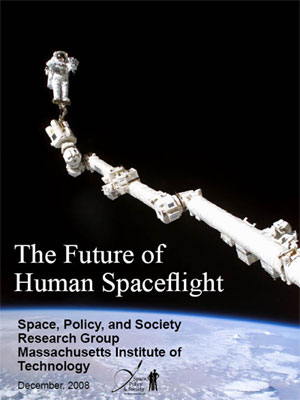Response to “The problems with ‘The Future of Human Spaceflight’”by David A. Mindell
|
| Oberg missed that our carefully chosen words present a radical thesis: human spaceflight should be justified by objectives that can only be accomplished with the physical presence of human beings, have benefits that exceed the opportunity costs, and are worthy of significant risk to human life. |
Despite this clear emphasis and flow, most of Oberg’s review criticizes the white paper’s use of what he calls “non-historic [sic] and deeply troubling myths.” These center on international collaboration, cost sharing, and causes of the Columbia disaster. We welcome criticism and will consider his points seriously as we prepare longer, more in-depth versions of the study. Nevertheless, the review responds primarily to its own straw men, misreadings, and oversimplifications of the text.
For example, Oberg takes the white paper to task for stating that, “human spaceflight is sufficiently difficult and expensive that international collaboration may be the only way to accomplish certain goals” and then ridicules as a “cosmic scale misconception” any recommendation for collaboration as a means of cost-sharing. This criticism is based on several errors. First, it is a simple and obvious fact that certain goals in human spaceflight are beyond the resources of the United States, especially at this time. Second, the review, in addition to overlooking the critical word “may,” seizes only on the “expensive” not on the “difficult”—it fails to consider the possibility that other nations might actually have skills and technology that could contribute to US efforts. Third, and most important, the white paper nowhere recommends cost-sharing as a rationale for international collaboration nor suggests that international collaboration would reduce mission costs. To the contrary, the white paper argues that international collaboration is a primary objective of human spaceflight on its own terms, for the national and international benefits it may (or may not) bring, and not a means of saving money.
The review also inaccurately extrapolates from the white paper’s single sentence on the Apollo Soyuz Test Program (ASTP): “The 1975 Apollo-Soyuz Test Project showcased an international gesture of cooperation between the United States and the Soviet Union at a time of tension between the nations.” Oberg reads into this sentence arguments that 1) the ASTP preceded détente; 2) it caused a relaxation of Cold War tensions; and 3) it supports a NASA claim that ASTP laid the groundwork for ending the Cold War. Our text neither says nor implies any of these things; it is merely an empirical description of an historical event (two historians of Soviet space contributed to the white paper). The white paper does go on to say that “human spaceflight can be an effective instrument of global diplomacy,” which the review calls “at best, silly, and at worst, 180 degrees away from reality.” Oberg either missed the crucial word “can” or he believes the opposite, that human spaceflight cannot under any circumstances be an effective instrument of US foreign policy and global diplomacy. While his previous writings may support this view, it places him at odds with historical evidence and with those who decide on, fund, participate, and observe such cooperative projects.
The most distracting part of the review is its responses to putative causes of the Columbia disaster. The white paper says: “The CAIB [Columbia Accident Investigation Board] report showed unequivocally how a constrained policy context, management failures, and inadequate funding contributed to the deaths of American astronauts.” This statement is based on the CAIB report, as quoted in the white paper: “NASA remained a politicized and vulnerable agency, dependent on key political players who accepted NASA’s ambitious proposals and then imposed strict budget limits… Policy constraints affected the Shuttle Program’s organizational culture, its structure, and the structure of the safety system. The three combined to keep NASA on its slippery slope toward Challenger and Columbia.” Nonetheless, the review inveighs against the idea that “it was lack of money that led to the Columbia disaster,” a misreading of both the white paper and the CAIB report.
Oberg goes on to misconstrue the above statements as pertaining to operations—as though bad decisions made by NASA managers and engineers during Columbia’s fatal flight resulted from inadequate funding. Here the review errs on both the CAIB report and Diane Vaughan’s book on Challenger (to which he alludes). Both focus on the inadequate funding of the shuttle less in operations than in the design phase in the 1970s that led to technical compromises and design decisions that ultimately sacrificed safety.
| We acknowledge much to argue about in the white paper; it addresses controversial issues and highly constrained circumstances. But it is time for fresh ideas. |
The review worries that the white paper seeks to let NASA off the hook for management failures and to lay the blame on the White House and Congress. I suspect we agree on the point that NASA has not yet fully acknowledged its own failures that contributed to the Columbia accident. Yet Oberg again misses the white paper’s argument: that where we are now, in the design and development phases of Constellation, the environment in some respects resembles that when the shuttle was under development and that a design based on too many compromises potentially heightens risks for years to come.
“The Future of Human Spaceflight” proposes a new way of thinking about this controversial national and human endeavor that holds promise as a basis for a coherent national and international policy. Our goal is to engage policymakers, experts, and the public. We acknowledge much to argue about in the white paper; it addresses controversial issues and highly constrained circumstances. But it is time for fresh ideas.
